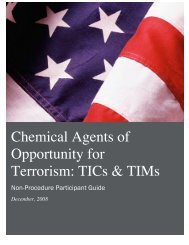Spring 2007 - American College of Medical Toxicology
Spring 2007 - American College of Medical Toxicology
Spring 2007 - American College of Medical Toxicology
Create successful ePaper yourself
Turn your PDF publications into a flip-book with our unique Google optimized e-Paper software.
acmt newsletter • spring <strong>2007</strong><br />
THE PRESIDENT’S PERSPECTIVE(continued from page 1)<br />
These are all questions that deserve serious discussion. Most<br />
fellowship training programs are poison center based, and yet<br />
there are at most about 63 FTE poison center medical director<br />
positions, and the total number <strong>of</strong> FTE positions around the<br />
country may be considerable less. These 0.5 and 1.0 FTE positions<br />
are certainly desirable, and such a practice is bread and<br />
butter medical toxicology, but they are limited in number and<br />
will not increase based on evolving consolidation <strong>of</strong> our current<br />
national poison center system. Of our 450 ACMT members,<br />
such poison center positions may support 50 members – perhaps<br />
1 in 9.<br />
Other medical toxicologists have valiantly tried to establish consultation<br />
or admitting services to care for patients with acute<br />
poisoning. Such endeavors can be extremely time consuming,<br />
and in the majority <strong>of</strong> cases such a practice does not generate a<br />
full time salary. Often there is just not enough volume <strong>of</strong> acute<br />
care cases to generate adequate revenue. A few have been successful,<br />
mostly by turning to care <strong>of</strong> patients with chronic (or<br />
questionable!) exposures or nonmedical services such as litigation<br />
support, but the numbers are low. The number <strong>of</strong> medical<br />
toxicologists who live <strong>of</strong>f a salary solely based on their inpatient<br />
clinical billings are very few indeed.<br />
How about other opportunities The outpatient practice <strong>of</strong> medical<br />
toxicology including occupational and environmental toxicology<br />
is a path chosen by relatively few members despite a<br />
demand for these services. While emergency physicians, hospitalists,<br />
and intensivists, may question the need to include a toxicologist<br />
on many acute poisonings, there are few other physicians<br />
(such as some occupational physicians) who will compete<br />
with the medical toxicologist in providing outpatient toxicology<br />
consultations. With such demand, and the relative dearth <strong>of</strong><br />
competitors, why shouldn’t this be a much more substantial<br />
component <strong>of</strong> medical toxicology practice To this end, have<br />
medical toxicology fellowship programs given training in occupational<br />
and environmental toxicology enough prominence<br />
In order to really develop a specialty that can support a full time<br />
practice (and integrate a new graduating class <strong>of</strong> 20-25 fellows<br />
year after year) perhaps we need to think outside the box. A few<br />
naysayers may argue that for most medical toxicologists, their<br />
toxicology practice is not meant to be economically self-supporting,<br />
and that they prefer to practice their primary area <strong>of</strong> specialization<br />
and dabble in medical toxicology. In many cases<br />
their mentors and role models have practiced this way, and this<br />
tradition is characteristically emulated by the trainees.<br />
But where does this leave medical toxicologists who would prefer<br />
to practice medical toxicology full time Perhaps we need to<br />
expand our skill set. If we look at the practice patterns <strong>of</strong> other<br />
physicians we observe the constant evolution <strong>of</strong> other specialties.<br />
Cardiologists taught themselves cardiac ultrasound<br />
(echocardiography), grabbing this skill set from Radiologists.<br />
Urological surgeons taught themselves urodynamics.<br />
Anesthestiologists (and others such as Neurologists) developed<br />
the subspecialty <strong>of</strong> pain management. Addiction specialists<br />
(usually Psychiatrists) have recently added buprenorphine management<br />
to their skill set. Even Gynecologists <strong>of</strong>ten <strong>of</strong>fer botox<br />
and other facial cosmetic procedures – far removed from their<br />
usual turf. These physicians looked outside the box pushing the<br />
traditional boundaries <strong>of</strong> their specialties.<br />
Should medical toxicologists do the same Should we take a<br />
much more proactive position and look for opportunities involving<br />
hyperbaric medicine, addiction medicine, or clinical pharmacology.<br />
How about selective (I mean very selective) chelation<br />
outside <strong>of</strong> heavy metal poisoning; or even botox itself<br />
In subsequent newsletters I will address how medical toxicologists<br />
may want to think outside this box.<br />
BOARD OF DIRECTORS<br />
In recent years a few medical toxicologists, both new grads as<br />
well as those at mid-career, have taken positions in the government,<br />
hired as medical toxicologists. These folks now work at<br />
ATSDR, CDC, EPA, and FDA. While the total number may not<br />
be more than a dozen, they are introducing the concept <strong>of</strong> medical<br />
toxicology to organizations without a track record <strong>of</strong> hiring<br />
medical toxicologists. These trail blazers are to be commended.<br />
President<br />
Paul M. Wax, MD, FACMT<br />
Vice President<br />
Erica L. Liebelt, MD, FACMT<br />
Secretary/Treasurer<br />
Lewis S. Nelson, MD, FACMT<br />
Immediate Past President<br />
Keith K. Burkhart, MD, FACMT<br />
Jeffrey Brent, MD, FACMT<br />
Daniel A. Goldstein, MD FACMT<br />
Christine A. Haller, MD<br />
Mark Kirk, MD, FACMT<br />
Steven A. Seifert, MD, FACMT<br />
Suzanne R. White, MD, FACMT<br />
3
















